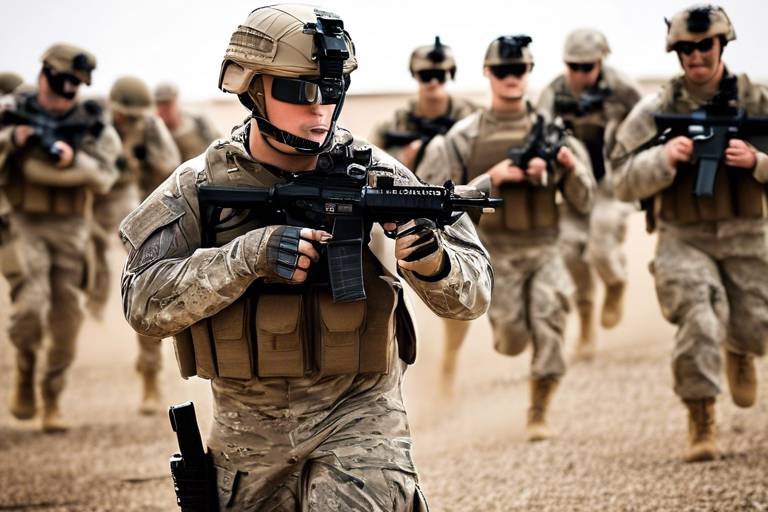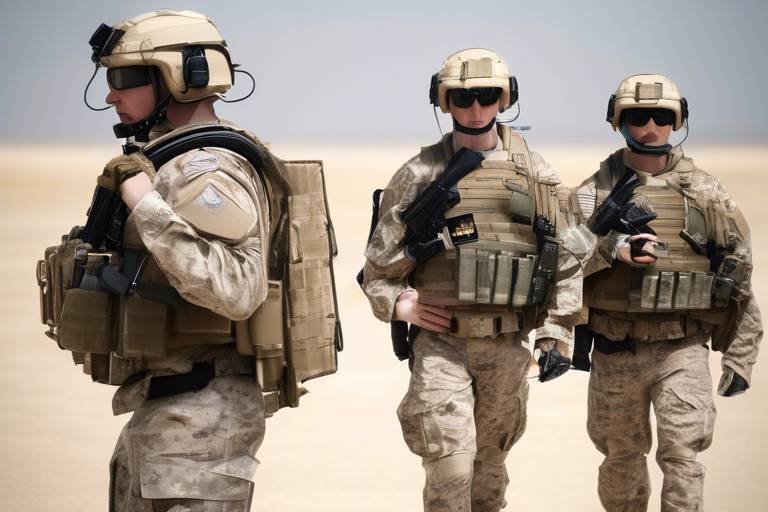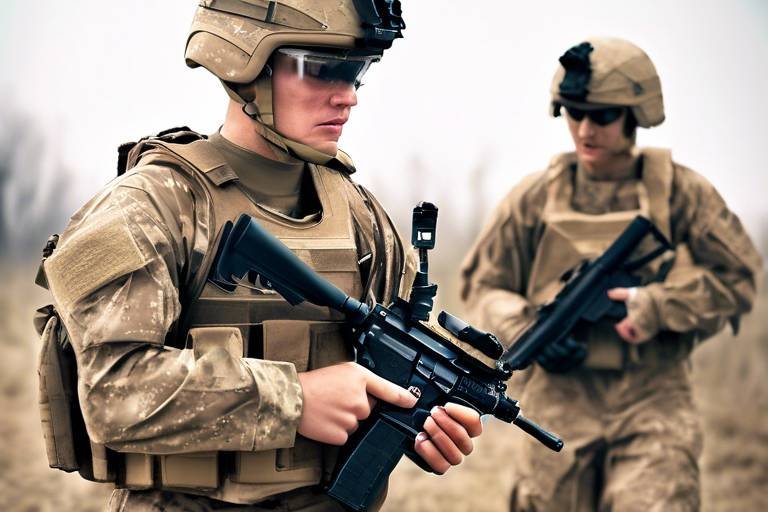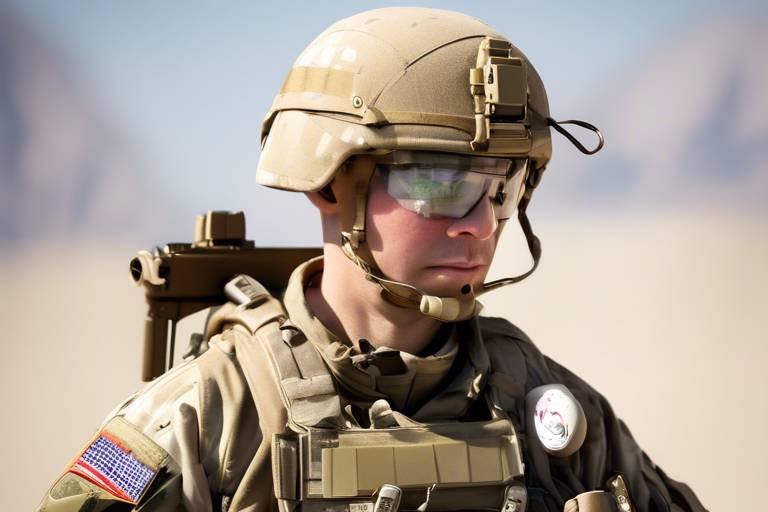The Application of Wearable Technologies in Military Simulations
In recent years, the military has witnessed a profound transformation thanks to the integration of wearable technologies into its training and operational frameworks. These devices, ranging from smartwatches to augmented reality (AR) glasses, are not just trendy gadgets; they are powerful tools that revolutionize how soldiers prepare for the complexities of real-world scenarios. Imagine a soldier donning a sleek, lightweight device that tracks their every movement, monitors vital signs, and provides live feedback—all while they navigate through a simulated battlefield. This isn't science fiction; it's the new reality of military training.
The application of wearable technologies in military simulations enhances training effectiveness and improves situational awareness. These devices allow for real-time data collection, enabling trainers and commanders to evaluate performance and health metrics instantly. By providing soldiers with immediate feedback, they can adjust their tactics and strategies on the fly, leading to more realistic training experiences. This level of engagement not only prepares soldiers for the physical demands of their roles but also sharpens their decision-making skills under pressure.
Moreover, the data collected from these wearable devices offers invaluable insights into the soldiers' performance and overall well-being. For instance, by analyzing movement patterns and physiological responses, military trainers can tailor programs that specifically address the needs of individual soldiers or teams. This personalized approach ensures that every service member is equipped with the skills and resilience necessary to face the challenges of modern warfare.
However, the journey toward fully integrating wearable technologies into military simulations isn't without its hurdles. From technical limitations, such as battery life and connectivity issues, to significant data security concerns, the military must navigate a complex landscape to harness the full potential of these innovations. Nevertheless, the future looks bright. With advancements in artificial intelligence, machine learning, and sensor technology on the horizon, we can expect even more sophisticated applications of wearable tech in military settings.
- What types of wearable technologies are used in military simulations?
Wearable technologies used include smartwatches, fitness trackers, and augmented reality glasses, each designed to enhance training and operational effectiveness. - How do wearable technologies improve soldier training?
They provide real-time data collection, health monitoring, and performance metrics, which help tailor training programs and enhance situational awareness. - What challenges do military organizations face when implementing wearable technologies?
Key challenges include technical limitations, data security concerns, and the need for thorough training on device usage. - What does the future hold for wearable technologies in military applications?
The future looks promising with advancements in AI and sensor technologies that will further enhance training capabilities and operational efficiency.
Overview of Wearable Technologies
Wearable technologies have become a buzzword in various industries, but their impact on the military is particularly fascinating. These devices, which include smartwatches, fitness trackers, and augmented reality glasses, are designed not just for tracking your steps or monitoring your heart rate, but for collecting critical data that can enhance military training and operations. Imagine a soldier equipped with a device that not only tracks their physical performance but also provides real-time feedback on their health and situational awareness. This is the future that wearable technologies promise.
At their core, wearable technologies are about enhancing user experience through data collection and real-time analysis. In military applications, these devices can monitor a range of metrics, from physiological responses to environmental conditions, allowing commanders to make informed decisions. For instance, a soldier wearing a fitness tracker can have their heart rate monitored continuously, alerting their superiors if they are under undue stress or fatigue. This immediate feedback loop is invaluable in high-stakes environments where every second counts.
Moreover, the integration of augmented reality (AR) into wearable tech adds another layer of functionality. Imagine soldiers wearing AR glasses that overlay critical information directly onto their field of vision. This could include navigation aids, enemy locations, and even health stats, all while keeping their hands free for their primary tasks. The possibilities are endless, and as technology continues to evolve, the potential applications in military simulations become even more exciting.
However, it's essential to understand that while the benefits are significant, the implementation of wearable technologies in military settings requires careful consideration. Factors such as battery life, connectivity, and durability must be addressed to ensure that these devices function effectively in the field. A device that fails to perform under harsh conditions can compromise not just training outcomes but also the safety of soldiers in real combat scenarios.
In summary, wearable technologies represent a transformative shift in how military training and operations are conducted. By providing real-time data and enhancing situational awareness, these devices can significantly improve the effectiveness and readiness of soldiers. As we continue to explore the potential of these technologies, it’s clear that they are not just tools; they are game-changers in the landscape of military simulations.
Benefits of Wearable Technologies in Military Training
Integrating wearable technologies into military training is not just a trend; it's a revolution that promises to reshape how soldiers prepare for real-world challenges. Imagine a world where every move, every heartbeat, and every environmental change is monitored in real-time, providing invaluable insights that can make the difference between success and failure in the field. This is the reality that wearable technologies bring to the table, enhancing the training experience in multiple ways.
One of the standout benefits of these technologies is the increased realism they offer. Traditional training methods often fall short in simulating the complexities of actual combat situations. However, with wearables, soldiers can engage in training exercises that mimic real-life scenarios more closely than ever before. This realism not only boosts engagement but also helps soldiers adapt to high-pressure situations, making them better prepared for the unexpected.
Furthermore, wearable technologies enable real-time data collection during training exercises. Commanders can monitor key performance metrics, health statistics, and environmental conditions as they happen. This immediate access to data is crucial for evaluating soldier readiness and effectiveness. For instance, if a soldier exhibits signs of fatigue or stress, commanders can intervene promptly, ensuring that the training remains safe and productive.
With wearables, data collection is no longer a post-training analysis but an ongoing process. Consider this: during a training exercise, a soldier's heart rate, movement patterns, and even environmental factors like temperature and humidity can be tracked in real-time. This data can then be analyzed to provide insights into individual and team performance. Commanders can adjust training scenarios on-the-fly based on this information, leading to a more adaptive and responsive training environment.
Health monitoring is another critical aspect of wearable technologies. These devices can track vital signs, fatigue levels, and stress indicators, giving instructors a comprehensive view of each soldier's physical and mental state. This capability is essential not only for enhancing performance but also for ensuring the well-being of soldiers during rigorous training sessions. After all, a soldier who is physically and mentally fit is far more likely to succeed in high-stakes situations.
Analyzing performance metrics is where wearable technologies truly shine. By capturing data on movement patterns and reaction times, these devices help identify areas for improvement. This means tailored training programs can be developed, focusing on specific skills that need enhancement. Imagine a soldier who struggles with quick decision-making under pressure; with the insights gained from wearables, trainers can create targeted drills that address these weaknesses, ultimately enhancing both individual and team effectiveness.
In summary, the integration of wearable technologies into military training offers a plethora of benefits that enhance realism, improve data collection, and provide critical feedback mechanisms. As soldiers become more prepared for the complexities of real-world missions, the military can ensure that its personnel are not just trained but are truly ready for any challenge that lies ahead.
- What types of wearable technologies are used in military training? Wearable technologies include smartwatches, fitness trackers, and augmented reality glasses, each designed to enhance training and operational effectiveness.
- How do wearable technologies improve soldier safety? By monitoring vital signs and stress levels, these devices can alert commanders to potential health issues, allowing for timely interventions.
- Are there any privacy concerns with wearable technologies? Yes, the sensitive nature of military data necessitates stringent data security measures to protect against breaches.
- What future advancements can we expect in wearable technologies for the military? Advancements in AI, machine learning, and sensor technology are expected to enhance the capabilities and effectiveness of wearables in military training and operations.
Real-Time Data Collection
In the fast-paced world of military training, the ability to collect data in real-time is nothing short of revolutionary. Imagine a training exercise where every movement, every heartbeat, and every environmental condition is monitored and analyzed instantaneously. This is the power of wearable technologies. These devices, equipped with advanced sensors, gather a wealth of information that can be crucial for evaluating soldier readiness and operational effectiveness.
For instance, during a simulated combat scenario, wearable devices can track a soldier's location, speed, and even their physiological responses. Commanders can access this data in real-time, allowing them to make quick, informed decisions on the fly. This immediate feedback loop not only enhances the training experience but also prepares soldiers for the unpredictability of real-life missions. The integration of real-time data collection into military training programs enables a level of responsiveness that was previously unattainable.
Furthermore, the data collected can be categorized into several critical areas:
- Performance Metrics: Metrics such as movement patterns, reaction times, and decision-making processes can be analyzed to pinpoint strengths and weaknesses.
- Health Statistics: Monitoring vital signs and stress levels provides insights into the physical and mental state of soldiers, ensuring they are fit for duty.
- Environmental Conditions: Wearable tech can also assess external factors like temperature, humidity, and altitude, which can significantly affect performance.
With this wealth of information, trainers can tailor their programs to address specific needs, enhancing both individual and team effectiveness. For example, if data shows that a soldier consistently struggles with endurance during high-stress scenarios, trainers can implement targeted exercises to improve stamina. This personalized approach not only boosts performance but also fosters a sense of empowerment among soldiers, as they see tangible improvements in their capabilities.
Moreover, the ability to analyze data trends over time can lead to more profound insights. By examining how soldiers adapt to various training conditions, military leaders can refine their strategies, ensuring that training remains relevant and effective. Ultimately, the integration of real-time data collection through wearable technologies represents a significant leap forward in military training, transforming how soldiers prepare for the complexities of modern warfare.
- What types of wearable technologies are used in military training?
Common devices include smartwatches, fitness trackers, and augmented reality glasses, all designed to monitor performance and health metrics. - How does real-time data collection improve military training?
It allows for immediate feedback on performance, health, and environmental factors, enabling tailored training programs and better preparedness for real-world scenarios. - What challenges are associated with wearable technologies in the military?
Challenges include technical limitations such as battery life and connectivity issues, as well as data security concerns that require robust protective measures.
Health Monitoring
In the fast-paced world of military training, has become a crucial component that can significantly impact a soldier's performance and safety. Wearable technologies, such as smartwatches and fitness trackers, are at the forefront of this evolution, offering real-time insights into various health metrics. Imagine being able to detect fatigue levels or stress indicators before they escalate into serious issues. This is not just a dream; it’s a reality that these advanced devices bring to the table. They continuously monitor vital signs, providing data that can be analyzed to ensure soldiers are operating at their best.
One of the standout features of these wearable devices is their ability to track vital signs such as heart rate, respiratory rate, and even body temperature. For instance, a soldier's heart rate can indicate not only their physical exertion but also their emotional state during high-pressure scenarios. If a soldier's heart rate spikes unexpectedly, it could signal that they are experiencing undue stress, allowing commanders to intervene and provide support before the situation worsens. This proactive approach can be the difference between success and failure in critical missions.
Moreover, wearable technologies can also monitor fatigue levels. In military operations, fatigue can severely impair cognitive functions and decision-making abilities. By analyzing data collected from wearables, commanders can identify soldiers who may be overexerted and require a break. This not only enhances individual well-being but also ensures that teams remain effective and cohesive in the field. The ability to visualize fatigue trends over time can lead to more informed decisions about training regimens and deployment schedules, ultimately fostering a culture of wellness within the ranks.
In addition to physiological monitoring, wearable technologies can provide insights into mental health, which is often overlooked in traditional training environments. Stress indicators, such as elevated heart rates or irregular breathing patterns, can be monitored discreetly, allowing soldiers to receive the necessary mental health support without stigma. This holistic approach to health monitoring ensures that soldiers are not only physically prepared but also mentally resilient.
To illustrate the importance of health monitoring in military settings, consider the following table that summarizes key health metrics tracked by wearable technologies and their implications:
| Health Metric | Importance |
|---|---|
| Heart Rate | Indicates physical exertion and emotional state |
| Respiratory Rate | Reflects stress levels and overall fitness |
| Body Temperature | Helps identify potential health issues |
| Fatigue Levels | Assesses readiness and need for rest |
| Stress Indicators | Guides mental health interventions |
In conclusion, the integration of health monitoring through wearable technologies in military training is a game changer. By providing real-time data on soldiers' physiological and psychological states, these devices empower commanders to make informed decisions that enhance readiness and safety. As technology continues to advance, the potential for these wearables to revolutionize health monitoring in the military is immense, paving the way for a future where soldiers can perform at their peak while maintaining their overall well-being.
Performance Metrics
Performance metrics are the lifeblood of military training, especially when integrating wearable technologies. Imagine being in a high-stakes simulation where every second counts. With wearable devices, commanders can access real-time data that reveals how soldiers are performing under pressure. This data isn't just numbers on a screen; it translates into actionable insights that can shape training programs and enhance operational effectiveness.
Wearable technologies track a variety of performance metrics, including movement patterns, reaction times, and even decision-making speed. For instance, if a soldier is consistently slower in executing maneuvers, this information can trigger tailored training sessions focused on agility and quick thinking. Think of it like a coach analyzing game footage to improve a player’s performance. By dissecting the data collected from wearables, trainers can pinpoint weaknesses and strengths, allowing for personalized coaching that leads to better outcomes in real-world scenarios.
Moreover, the ability to analyze performance metrics extends beyond individual soldiers. It can also enhance team dynamics. Wearable technologies can monitor how well units work together during simulations, revealing patterns in communication and coordination. This information is invaluable because, in military operations, the success of a mission often hinges on how well a team collaborates. By understanding these dynamics, military leaders can implement strategies that foster better teamwork and ultimately lead to mission success.
To illustrate the importance of performance metrics, consider the following table that summarizes key metrics tracked by wearable devices:
| Metric | Description | Importance |
|---|---|---|
| Movement Patterns | Tracks the physical movements of soldiers during training exercises. | Helps identify areas for improvement in agility and speed. |
| Reaction Times | Measures how quickly soldiers respond to stimuli. | Critical for assessing readiness in fast-paced environments. |
| Decision-Making Speed | Evaluates how quickly soldiers make tactical decisions. | Vital for success in high-pressure situations. |
By utilizing these performance metrics, military training can evolve from a one-size-fits-all approach to a more customized experience. This not only improves the individual soldier's capabilities but also enhances the overall effectiveness of military units. In the end, the integration of wearable technology into performance metrics is not just about collecting data; it's about transforming that data into a powerful tool for training and operational success.
- What types of wearable technologies are used in military simulations?
Wearable technologies include smartwatches, fitness trackers, augmented reality glasses, and specialized sensors designed for military applications.
- How do performance metrics improve military training?
Performance metrics provide real-time data that helps identify strengths and weaknesses, allowing for tailored training programs that enhance soldier readiness and effectiveness in the field.
- What are the challenges of using wearable technologies?
Challenges include technical limitations such as battery life and connectivity issues, as well as data security concerns that arise from handling sensitive military information.
- What is the future of wearable technologies in the military?
The future looks promising with advancements in AI, machine learning, and sensor technology, which are expected to enhance training capabilities and operational effectiveness.
Enhanced Situational Awareness
In the fast-paced world of military operations, situational awareness is not just a buzzword; it’s a lifeline. Imagine being in a high-stakes scenario where every second counts. Wearable technologies are revolutionizing how soldiers perceive and interact with their environment, providing them with critical information right when they need it. These devices, like augmented reality glasses and smart helmets, overlay vital data onto the soldier's field of vision, transforming the way they process information during both training and real missions.
Think of it this way: when you're driving, having a GPS system that provides real-time traffic updates and directions can make all the difference. Similarly, wearable tech serves as a GPS for soldiers, guiding them through complex terrains and scenarios by delivering essential intelligence. This could include enemy locations, troop movements, and even environmental hazards, all of which help soldiers make informed decisions swiftly and accurately.
Moreover, the integration of wearable technologies enhances communication among team members. For instance, with devices that allow for voice commands and hands-free operation, soldiers can share information without breaking their focus. This seamless communication is crucial in high-pressure situations where every moment matters. Imagine a squad operating in a dense forest, where visibility is low. With wearable tech, they can receive updates on their teammates' status and location, enabling them to coordinate actions effectively.
Additionally, the data collected from these devices can be used to create a comprehensive overview of the battlefield. This information can be analyzed to identify patterns and predict potential threats, thereby allowing military planners to devise more effective strategies. For example, if a certain area consistently shows increased enemy activity, military leaders can allocate resources more efficiently, ensuring that soldiers are prepared for potential engagements.
However, the true power of wearable technologies lies in their ability to adapt and evolve. As advancements in artificial intelligence and machine learning continue to develop, these devices will become even more intuitive, learning from past missions to provide personalized insights for each soldier. The future is bright, and the potential for enhanced situational awareness through wearable tech is vast.
- What are wearable technologies? Wearable technologies refer to devices like smartwatches, fitness trackers, and augmented reality glasses that collect data and enhance user experience.
- How do wearable technologies improve military training? They increase realism, improve data collection, and enhance feedback mechanisms, leading to better-prepared soldiers.
- What challenges do wearable technologies face in military applications? Challenges include technical limitations, data security concerns, and the need for thorough training on device usage.
- What is the future of wearable technologies in the military? The future looks promising with advancements in AI, machine learning, and sensor technology enhancing capabilities in training and operations.
Challenges of Implementing Wearable Technologies
While the integration of wearable technologies into military simulations presents a plethora of benefits, it is not without its challenges. One of the primary hurdles is the technical limitations that these devices face in the field. For instance, issues such as battery life constraints can significantly impact the usability of wearable devices during extended training exercises. Imagine a soldier in the midst of a critical operation, only to have their device fail due to a depleted battery. This scenario underscores the importance of developing more robust power solutions.
Additionally, connectivity problems can arise, particularly in remote or rugged terrains where signal strength is weak. This lack of connectivity can hinder the real-time data sharing that is crucial for effective military operations. Furthermore, the durability of these devices is a concern; they must withstand harsh environmental conditions, including extreme temperatures, moisture, and physical impacts. If a device cannot endure the rigors of military life, its effectiveness is severely compromised.
Another significant issue is data security concerns. The sensitive nature of military operations means that any data collected by wearable technologies must be protected against potential breaches. Cybersecurity must be a top priority, necessitating the implementation of robust encryption protocols and secure data handling practices. The last thing any military organization wants is for critical information to fall into the wrong hands.
Moreover, there’s the need for thorough training on device usage. Soldiers must be well-versed in how to operate these technologies to maximize their potential benefits. This training requires time and resources, which can be a challenge in itself. If soldiers are not adequately trained, the devices may not be used to their full capacity, leading to a waste of valuable resources.
In summary, while wearable technologies hold great promise for enhancing military simulations, their implementation is fraught with challenges. Addressing these issues will be crucial for maximizing their effectiveness in training and operational settings. As the military continues to explore these technologies, it will be essential to develop solutions that mitigate these challenges to ensure that soldiers can leverage the full potential of wearable tech in the field.
- What are wearable technologies?
Wearable technologies include devices like smartwatches, fitness trackers, and augmented reality glasses that collect data and enhance user experience. - How do wearable technologies benefit military training?
They provide real-time data collection, health monitoring, and performance metrics, leading to better-prepared soldiers. - What are the main challenges of implementing these technologies?
Challenges include technical limitations, data security concerns, and the need for thorough training on device usage. - What advancements are expected in the future for wearable technologies?
Future advancements may include improvements in AI, machine learning, and sensor technology to enhance capabilities in military applications.
Technical Limitations
While the integration of wearable technologies in military simulations opens up a world of possibilities, it is crucial to acknowledge the that accompany these innovations. Imagine gearing up for an intense training exercise, only to find that your device's battery is running low. This scenario highlights one of the primary concerns: battery life. Many wearable devices are designed for everyday use, but in the demanding military environment, where long-lasting performance is vital, battery constraints can severely limit operational effectiveness. Soldiers need devices that can withstand extended periods of use without frequent recharging, especially during long missions.
Moreover, connectivity problems can arise in remote or rugged terrains where cellular signals are weak or nonexistent. This lack of connectivity can hinder the real-time data transmission that is essential for monitoring soldier performance and health metrics. Imagine a soldier in the field relying on a wearable device that cannot communicate crucial data back to command due to poor signal strength. Such scenarios can lead to significant gaps in situational awareness, compromising both training outcomes and operational safety.
Another challenge lies in the durability of these devices. Military operations often occur in harsh conditions, exposing wearables to extreme temperatures, moisture, and physical impacts. If a device malfunctions due to environmental factors, it can render it useless when it is needed the most. Therefore, manufacturers must prioritize creating robust wearables that can endure the rigors of military life without sacrificing functionality.
In addition to these challenges, the integration of wearable technologies requires a thorough understanding of their user interface and functionality. Soldiers must be adequately trained to use these devices effectively, which can be a time-consuming process. If users are not familiar with the technology, it can lead to errors and inefficiencies during critical moments. Thus, investing in comprehensive training programs is essential to ensure that military personnel can leverage the full potential of wearable technologies.
To summarize, while wearable technologies offer remarkable benefits in military simulations, they are not without their hurdles. Addressing these technical limitations is vital for maximizing the effectiveness of these devices in enhancing training and operational readiness. As advancements continue to emerge, it is essential for military organizations to remain vigilant and proactive in overcoming these challenges.
- What are the main technical limitations of wearable technologies in military simulations?
The main limitations include battery life constraints, connectivity issues, durability challenges in harsh environments, and the need for thorough user training. - How can battery life issues be mitigated?
Utilizing advanced battery technologies, such as energy-efficient components and solar charging options, can help extend the operational life of wearable devices. - What steps can be taken to improve connectivity in remote areas?
Implementing mesh networking solutions or using satellite communication can enhance connectivity for wearable devices in challenging terrains. - Why is user training important for military wearables?
Proper training ensures that soldiers can effectively use the technology, reducing the risk of errors and maximizing the benefits of real-time data collection.
Data Security Concerns
When it comes to the integration of wearable technologies in military simulations, one of the most pressing issues is data security. The sensitive nature of military operations means that any information collected through these devices is not just valuable; it could be critical to national security. Imagine a scenario where a soldier's health data or operational metrics fall into the wrong hands. The implications could be dire, affecting not only individual soldiers but also entire missions and strategies.
Wearable devices, while incredibly beneficial, can also be vulnerable to various forms of cyber threats. Hackers are continuously looking for ways to exploit weaknesses in technology, and military-grade wearables must be fortified against such attacks. This is where robust encryption and cybersecurity measures become essential. These technologies must ensure that any data transmitted or stored is protected from unauthorized access. For instance, if a device is compromised, it could lead to the exposure of vital information such as troop movements, locations, or even health status, which adversaries could use to their advantage.
Moreover, the challenge extends beyond just securing the data itself. There’s also the matter of educating personnel on the proper use of these devices. Soldiers must be trained not only on how to use the wearables effectively but also on the potential risks associated with them. This includes understanding how to recognize phishing attempts or other social engineering tactics that could lead to data breaches.
To address these concerns, military organizations are investing in advanced security protocols and regularly updating their systems to counteract emerging threats. This includes implementing multi-factor authentication, conducting regular security audits, and ensuring that all wearable technologies comply with stringent security standards. The goal is to create a secure environment where soldiers can benefit from wearable tech without compromising sensitive information.
In summary, while the integration of wearable technologies in military simulations offers numerous advantages, it is imperative to prioritize data security. By doing so, military organizations can harness the full potential of these innovative tools while safeguarding the information that is critical to their operations.
- What types of data do wearable technologies collect in military simulations?
Wearable technologies can collect a variety of data, including health metrics (like heart rate and fatigue levels), performance metrics (such as movement patterns), and environmental conditions during training exercises. - How can data security be ensured for wearable technologies?
Data security can be enhanced through robust encryption, multi-factor authentication, regular security audits, and thorough training for personnel on the risks associated with these devices. - What are the potential risks of using wearable technologies in military operations?
Potential risks include data breaches, unauthorized access to sensitive information, and the possibility of device malfunction in critical situations. - Are there any specific regulations governing the use of wearable technologies in the military?
Yes, military organizations often have strict regulations and standards that govern the use of technology, including wearable devices, to ensure data security and operational effectiveness.
Future Trends in Wearable Technologies for Military Use
This article explores how wearable technologies are transforming military simulations, enhancing training, improving situational awareness, and providing valuable data for decision-making in complex environments.
Wearable technologies encompass devices like smartwatches, fitness trackers, and augmented reality glasses, designed to collect data and enhance user experience in various applications, including military training and operations.
Integrating wearable technologies into military training offers numerous benefits, such as increased realism, improved data collection, and enhanced feedback mechanisms, ultimately leading to better-prepared soldiers in real-world scenarios.
Wearable devices enable real-time data collection during training exercises, allowing commanders to monitor performance metrics, health statistics, and environmental conditions, which can be crucial for evaluating soldier readiness.
Wearable technologies can track vital signs, fatigue levels, and stress indicators, providing insights into soldiers’ physical and mental states, which is essential for ensuring their well-being during training and operations.
By analyzing performance metrics such as movement patterns and reaction times, wearable technologies help identify areas for improvement, allowing for tailored training programs that enhance individual and team effectiveness.
Wearable technologies improve situational awareness by providing soldiers with critical information directly in their field of view, helping them make informed decisions quickly and effectively during simulations and real missions.
Despite their advantages, implementing wearable technologies in military simulations presents challenges, including technical limitations, data security concerns, and the need for thorough training on device usage.
Wearable devices may face issues such as battery life constraints, connectivity problems, and durability concerns in harsh environments, which can hinder their effectiveness in military applications.
The sensitive nature of military operations raises significant data security concerns when using wearable technologies, necessitating robust encryption and cybersecurity measures to protect information from potential breaches.
The future of wearable technologies in military simulations looks incredibly promising. As advancements in artificial intelligence, machine learning, and sensor technology continue to evolve, we can expect these innovations to significantly enhance capabilities and effectiveness in both training and operational settings. Imagine a scenario where soldiers are equipped with smart helmets that not only provide real-time data but also utilize AI to predict potential threats based on environmental cues. This could revolutionize how military personnel engage in simulations and real missions, making them more prepared for unpredictable situations.
Moreover, the integration of augmented reality (AR) into wearable technologies is anticipated to create immersive training environments that simulate real-life combat scenarios. These AR systems can overlay crucial information directly onto the soldier's field of view, allowing them to visualize tactical data without diverting their attention from the mission at hand. Such enhancements will not only improve decision-making speed but also bolster team coordination during complex operations.
Additionally, the rise of biometric sensors will enable continuous monitoring of soldiers' physiological and psychological states, offering insights that can be used to tailor training programs and operational strategies. For instance, if a soldier shows signs of extreme fatigue or stress, commanders can adjust their workload or provide necessary support to ensure optimal performance. The potential for these technologies to facilitate a more adaptive and responsive military training program is immense.
In summary, the future of wearable technologies in military use is set to be shaped by ongoing technological advancements, leading to enhanced training experiences and improved operational effectiveness. As we continue to explore these innovations, it becomes clear that the integration of wearable technologies will not only change the way military simulations are conducted but also redefine the very fabric of military preparedness.
- What are wearable technologies? Wearable technologies include devices such as smartwatches, fitness trackers, and augmented reality glasses that collect data and enhance user experience.
- How do wearable technologies benefit military training? They provide real-time data collection, health monitoring, performance metrics, and enhanced situational awareness, leading to better-prepared soldiers.
- What challenges exist in implementing wearable technologies in the military? Challenges include technical limitations, data security concerns, and the need for comprehensive training on device usage.
- What future trends can we expect in wearable technologies for military use? Future trends include advancements in AI, machine learning, augmented reality, and biometric sensors that enhance training and operational effectiveness.
Frequently Asked Questions
- What are wearable technologies in military simulations?
Wearable technologies in military simulations refer to devices like smartwatches, fitness trackers, and augmented reality glasses that are designed to collect data and enhance the training experience for soldiers. These gadgets help in monitoring health, performance, and situational awareness during training exercises.
- How do wearable technologies improve military training?
By integrating wearable technologies, military training becomes more realistic and effective. These devices facilitate real-time data collection, which allows commanders to monitor vital statistics and environmental conditions, ultimately helping to prepare soldiers for real-world scenarios.
- What kind of data can wearable devices collect during training?
Wearable devices can collect a variety of data, including health metrics like heart rate and fatigue levels, as well as performance metrics such as movement patterns and reaction times. This information is crucial for evaluating soldier readiness and tailoring training programs to improve performance.
- Can wearable technologies help with health monitoring in the military?
Absolutely! Wearable technologies are capable of tracking vital signs and stress indicators, providing insights into a soldier's physical and mental state. This monitoring is essential for ensuring the well-being of soldiers during both training and operational missions.
- What challenges are associated with implementing wearable technologies?
While wearable technologies offer significant benefits, there are challenges such as technical limitations, data security concerns, and the necessity for comprehensive training on how to use these devices effectively in military environments.
- How can data security be ensured when using wearable technologies?
To protect sensitive military data, robust encryption and cybersecurity measures must be implemented. This is vital to safeguard information from potential breaches, ensuring that operational security is maintained while using wearable devices.
- What does the future hold for wearable technologies in the military?
The future of wearable technologies in military simulations looks bright, with advancements in AI, machine learning, and sensor technology expected to enhance capabilities. These innovations will likely lead to more effective training and operational settings, improving overall military readiness.


















